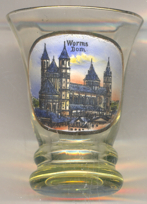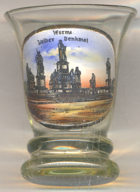

|
| DEUTSCHLAND | GERMANY |
| Bundesland: Rheinland-Pfalz | Rhineland-Palatinate |
| Stadt: Worms |
Worms is situated at an elevation of 100 m on the left bank of he river Rhine, about 40 km south of Mainz and 20 km north of Ludwigshafen. The municipality has a population of about 83,100 (2017).
In Roman times, the town was known as Borbetomagus of Bormetomagus, a name that indicates its Celtic origin. The Romans renamed the city as Augusta Vangionum. However, the German Worms developed from the older Celtic name. Worms has been a bishopric since at least 614, with an even earlier mention in 346. In the Frankish Empire, the city was the location of an important palatinate of Charlemagne, who built one of his many administrative palaces here. The bishops administered the city and its territory. Worms prospered in the High Middle Ages. Having received far-reaching privileges as early as 1074, the city later became an Imperial Free City, being independent of any local ruler and responsible only to the Holy Roman Emperor himself. As a result, Worms was the site of several important events in the history of the Empire. In 1122 the Concordat of Worms was signed; in 1495, an Imperial Diet met here and made an attempt at reforming the disintegrating Imperial Circle Estates by the Imperial Reform. Most important, among more than a hundred Imperial Diets held at Worms, that of 1521 (commonly known as the Diet of Worms) ended with the Edict of Worms, in which Martin Luther was declared a heretic after refusing to recant his religious beliefs. Worms was also the birthplace of the first Bibles of the Reformation, both Martin Luther's German Bible and William Tyndale's first complete English New Testament by 1526. In 1743 the Treaty of Worms was signed, forming a political alliance between Great Britain, Austria and the Kingdom of Sardinia. In 1792 the city was occupied by troops of the French First Republic during the French Revolutionary Wars. Worms was the seat of the Catholic Prince-Bishopric of Worms until its extinction during German mediatisation. The Bishopric of Worms was secularized in 1801, with the city being annexed into the First French Empire. In 1815 Worms passed to the Grand Duchy of Hesse (Hesse-Darmstadt) in accordance with the Congress of Vienna and the city was subsequently administered within the province Rhenish Hesse. Worms was a German strongpoint on the west bank of the Rhine and thus it was heavily bombed by during World War II in 1945. A post-war survey estimated that 39% of the town's developed area was destroyed. Today, the city is an important industrial centre. In 2021, the medieval jewish cemetry of Worms was inscribed (together with the medieval jewish sites of Speyer and Mainz) in the UNESCO list of World Cultural Heritage sites. (see also list of other UNESCO heritage sites depicted on glasses of this collection)
 The history of the
The history of the  former cathedral of St. Peter [left, no. 3604] goes back to a first
church that had been founded here in the 7th century AD on top of the former Roman forum. The present church was laid
out at the beginning of the 11th century. In 1018, the cathedral was consecrated in the presence of the Emperor, but
the western part of the building collapsed only two years later and had to be rebuilt. Only the foundations of the west
towers and the treasury north of the choir, which was probably built at the end of the 11th century, survived subsequent
rebuilding. In 1110, the cathedral was consecrated for the second time. Around 1130, probably because of further damage to
the building, the construction of a new church was begun. The whole eastwerk with its towers and cupola were completed by
c.1144. The nave and westwerk were erected between 1160 and 1181. The cathedral has features of the late Romanesque style,
such as being completely vaulted and is decorated in line with Burgundian-Cistercian influence. Since part of the northwest
tower collapsed in 1429, it was under reconstruction until 1472. After the Nine Years' War (1688–1697), the cathedral
was restored in 1698. During the Fench Revolution, Worms, like Speyer,
Mainz and Frankfurt was sacked by the revolutionary troops and the
cathedral served as a stable and tavern. A full renovation of the cathedral only began in 1886. After the extinction of
the Prince-Bishopric in 1801 it was reduced in status to that of a parish church, however it was bestowed the title
Basilica minor in 1925.
(see also list of other basilicae minores depicted on glasses of this collection)
former cathedral of St. Peter [left, no. 3604] goes back to a first
church that had been founded here in the 7th century AD on top of the former Roman forum. The present church was laid
out at the beginning of the 11th century. In 1018, the cathedral was consecrated in the presence of the Emperor, but
the western part of the building collapsed only two years later and had to be rebuilt. Only the foundations of the west
towers and the treasury north of the choir, which was probably built at the end of the 11th century, survived subsequent
rebuilding. In 1110, the cathedral was consecrated for the second time. Around 1130, probably because of further damage to
the building, the construction of a new church was begun. The whole eastwerk with its towers and cupola were completed by
c.1144. The nave and westwerk were erected between 1160 and 1181. The cathedral has features of the late Romanesque style,
such as being completely vaulted and is decorated in line with Burgundian-Cistercian influence. Since part of the northwest
tower collapsed in 1429, it was under reconstruction until 1472. After the Nine Years' War (1688–1697), the cathedral
was restored in 1698. During the Fench Revolution, Worms, like Speyer,
Mainz and Frankfurt was sacked by the revolutionary troops and the
cathedral served as a stable and tavern. A full renovation of the cathedral only began in 1886. After the extinction of
the Prince-Bishopric in 1801 it was reduced in status to that of a parish church, however it was bestowed the title
Basilica minor in 1925.
(see also list of other basilicae minores depicted on glasses of this collection)
 The
The  Luther monument [near left, no. 3605] is a group of statues that was
erected in 1868 to commemorate the Protestant reformer Martin Luther. The monument consists of a group of bronze statues on
stone plinths centred on a statue of Luther, surrounded by statues of related individuals and allegorical statues
representing related towns. The elements are arranged in the shape of a castle, recalling Luther's hymn "Ein feste Burg ist
unser Gott" ("A Mighty Fortress Is Our God"). It is one of the largest Luther Monuments. Copies of the central Luther
statue are located in several places in Europe and the United States, including the Luther Monument in
Washington, D.C. (1884). The monument was designed by the German sculptor Ernst Rietschel.
Luther monument [near left, no. 3605] is a group of statues that was
erected in 1868 to commemorate the Protestant reformer Martin Luther. The monument consists of a group of bronze statues on
stone plinths centred on a statue of Luther, surrounded by statues of related individuals and allegorical statues
representing related towns. The elements are arranged in the shape of a castle, recalling Luther's hymn "Ein feste Burg ist
unser Gott" ("A Mighty Fortress Is Our God"). It is one of the largest Luther Monuments. Copies of the central Luther
statue are located in several places in Europe and the United States, including the Luther Monument in
Washington, D.C. (1884). The monument was designed by the German sculptor Ernst Rietschel.
[https://de.wikipedia.org/wiki/Worms, https://en.wikipedia.org/wiki/Worms,_Germany;
https://en.wikipedia.org/wiki/Worms_Cathedral;
https://en.wikipedia.org/wiki/Luther_Monument_(Worms)]
![[scale]](lineal.jpg)